Transform your fence into a buzzing pollinator paradise with native vines like Trumpet Honeysuckle, Crossvine, and Passion Vine. These flowering climbers attract bees, butterflies, and hummingbirds while providing essential habitat. For continuous blooms, mix early-flowering Carolina Jessamine with summer stars like Black-Eyed Susan Vine and late-season Honeysuckle. Quick-growing options include Morning Glory and Virginia Creeper, which reach impressive heights in a single season. Discover how these living fences support your local ecosystem below.
Native Vines: The Foundation of Your Pollinator Fence
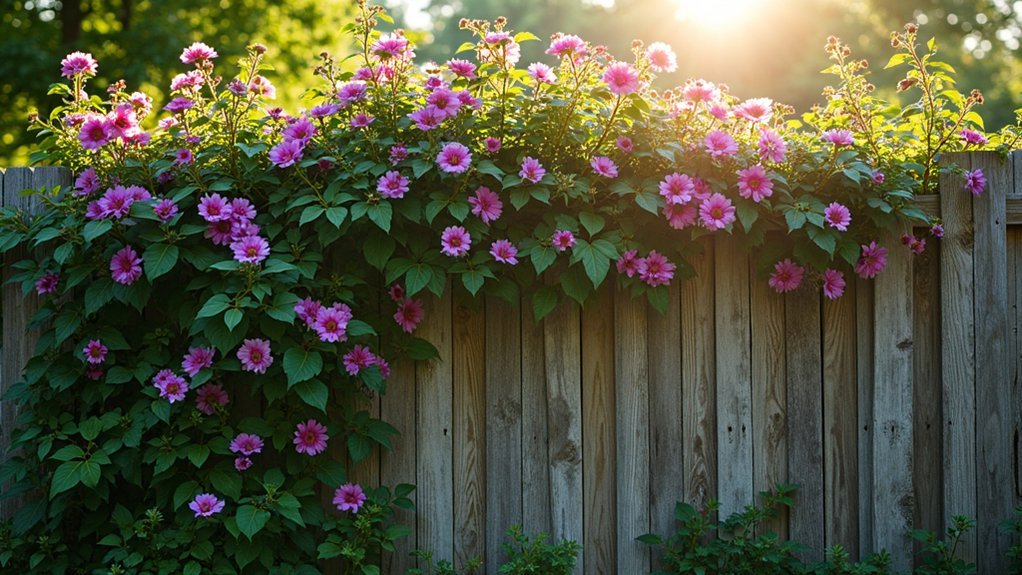
While any flowering vine can add vertical interest to your garden, native vines serve as the cornerstone of a thriving pollinator habitat. These specialized plants provide essential nectar sources that fuel local ecosystems.
Consider adding Trumpet Honeysuckle or Carolina Jessamine to your fence line—both attract hummingbirds, bees, and butterflies with their abundant blooms.
Transform your garden boundaries into wildlife destinations by planting nectar-rich vines that become buzzing hotspots for winged visitors.
Bignonia capreolata (Crossvine) rapidly covers structures with mocha-scented flowers that early hummingbirds can’t resist.
Don’t overlook Virginia Creeper, which not only supports pollinators but produces fruits that birds love.
For a stunning display, plant Passion Vine (Passiflora incarnata) to create a leafy curtain with fragrant purple flowers that bloom for months.
Colorful Climbers That Attract Bees and Butterflies
Beyond native options, a world of vibrant climbing vines can transform your fence into a pollinator magnet. Honeysuckle varieties offer nectar-rich blooms in multiple colors that’ll bring bees, butterflies, and hummingbirds flocking to your garden.
For dramatic impact, consider ‘Amethyst Falls’ Wisteria, whose fragrant blue cascades create both visual appeal and essential habitat for beneficial insects.
Morning Glory provides fast coverage of vertical spaces with trumpet-shaped flowers that pollinators can’t resist.
Don’t overlook climbing roses like ‘Oxford Girl’ – their strong scent and abundant blooms make them irresistible to pollinators while beautifying your fence.
Seasonal Blooming Strategies for Year-Round Pollinators
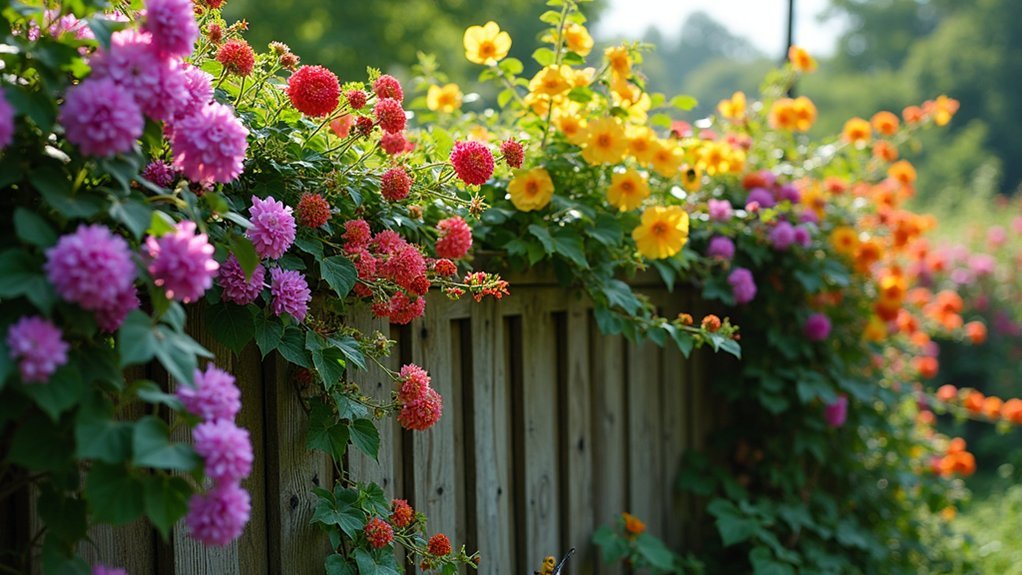
You’ll maximize your garden’s pollinator support by strategically planting vines that bloom in sequence from spring to fall, such as Wisteria followed by Clematis and then Passion Vine.
Even during dormant months, your vine infrastructure can provide essential shelter for overwintering insects if you leave seed heads and dried stems intact.
This thoughtful succession planning guarantees your garden serves as a continuous resource hub for bees, butterflies, and other beneficial creatures throughout their entire active cycle.
Spring-to-Fall Succession Planning
Creating a continuous buffet for pollinators requires thoughtful succession planning with your flowering vines. Start with early spring bloomers like Carolina Jessamine, a native species that attracts the season’s first hungry pollinators.
As spring progresses, add Wisteria and Clematis to intensify nectar availability.
For summer shifts, incorporate Black-Eyed Susan Vine alongside fast-growing Morning Glory, which will bloom prolifically until fall. These summer standouts bridge the gap between spring and autumn perennial offerings.
Don’t overlook late-season performers like Honeysuckle that provide essential fall nectar when other sources diminish.
Remember to deadhead regularly to extend blooming periods of your flowering vines. By carefully selecting varieties with overlapping bloom times, you’ll create an uninterrupted nectar supply that supports diverse pollinators throughout the growing season.
Dormant Season Support Systems
The dormant season offers critical opportunities to establish robust support systems for your flowering vine sanctuary. While your garden appears quiet, you’re actually setting the stage for next year’s pollinator paradise.
Install sturdy trellises now to support your climbing vines’ spring growth and subsequent pollinator activity. This quieter period is perfect for strategic pruning and maintenance of existing vines to promote vigorous blooming cycles.
| Support Type | Best For | Installation Timing |
|---|---|---|
| Wooden Lattice | Wisteria, Clematis | Early Winter |
| Metal Arbors | Native vines, Honeysuckle | Mid-Winter |
| Wire Systems | Morning Glory, Trumpet Vine | Late Winter |
| Living Supports | Virginia Creeper | Fall |
| Pergolas | Mixed flowering vines | Before Ground Freeze |
Incorporate companion planting alongside your vines to create diverse nectar and habitat sources that’ll sustain pollinators throughout their active seasons.
Supporting Your Vines: Trellis and Structure Options
Every successful flowering vine garden begins with proper structural support. Your climbing vines need reliable trellises to grow upward, maximizing sun exposure for abundant blooms that attract pollinators.
Choose materials based on your vine’s weight—wood and metal offer sturdy options for heavier species like wisteria, while wire systems work well for lighter varieties.
Sturdy supports for heavyweight bloomers, delicate systems for lighter climbers—match your trellis to your vine’s ambition.
Vertical structures such as arbors and pergolas do double duty, supporting your flowering vines while creating shaded sanctuaries for bees and butterflies.
Don’t overlook proper spacing and anchoring; vigorous growth can topple poorly secured supports.
Consider combining different trellis types—mesh and lattice work together to accommodate various climbing habits, fostering a biodiverse environment where pollinators thrive.
Your thoughtful structure choices now will yield a magnificent living tapestry of blooms later.
The Hummingbird Magnets: Trumpet-Shaped Blooms
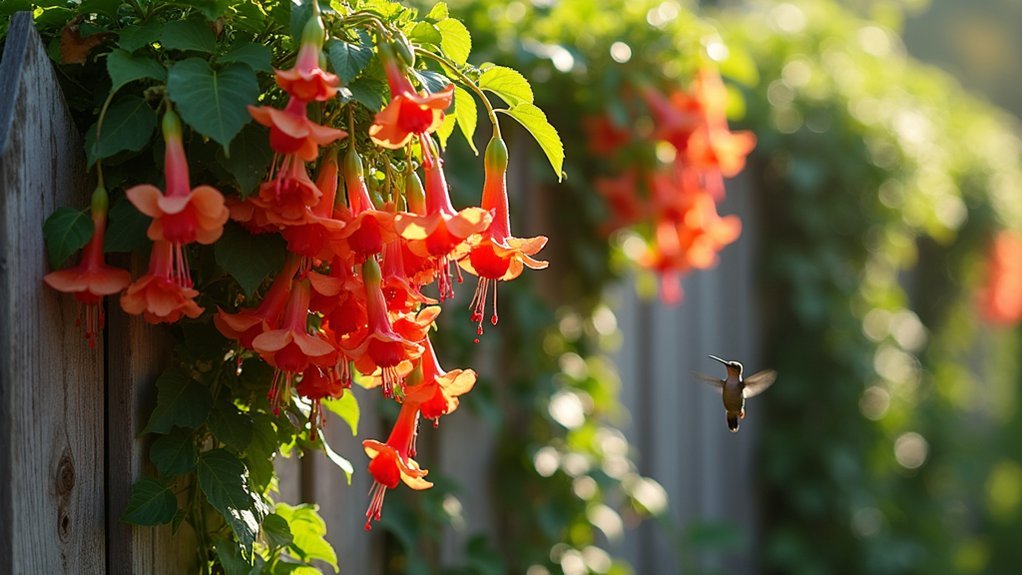
Vibrant trumpet-shaped blooms transform ordinary garden spaces into hummingbird havens through their specialized design and abundant nectar. The tubular flowers of Trumpet Vine (Campsis radicans) and Honeysuckle create the perfect feeding stations for these tiny pollinators while excluding larger competitors.
You’ll find these pollinator-friendly vines particularly essential during warm seasons when hummingbirds are most active. Their specialized relationship benefits both parties—the birds receive crucial nutrition while the plants gain efficient pollination services.
For maximum impact in your garden, combine varieties like Trumpet Creeper and Carolina Jessamine along fences. These showstoppers thrive in full sun and well-draining soil, creating not just a stunning visual display but a critical ecological resource.
As these vines bloom, they’ll turn your ordinary fence into a vibrant wildlife sanctuary.
Drought-Tolerant Vines for Sustainable Boundaries
Smart gardeners appreciate that water conservation doesn’t mean sacrificing beauty along your garden boundaries.
Drought-tolerant flowering vines like Wisteria and Blue Sky Vine offer stunning vertical gardening solutions while minimizing water usage.
Amethyst Falls Wisteria grows up to 30 feet tall, creating magnificent green screens that deer avoid.
Reach for the sky with Amethyst Falls Wisteria—nature’s deer-resistant curtain for the water-conscious gardener.
For vibrant color, consider Bougainvillea, whose paper-like bracts thrive in heat with minimal watering once established.
Native vines deliver exceptional sustainability benefits.
Crossvine and Carolina Jessamine not only survive dry conditions but attract essential pollinators with their fragrant blooms.
The unique Chocolate Vine offers chocolate-scented flowers while extending over 30 feet with little water.
Fragrant Flowering Vines That Entice Beneficial Insects
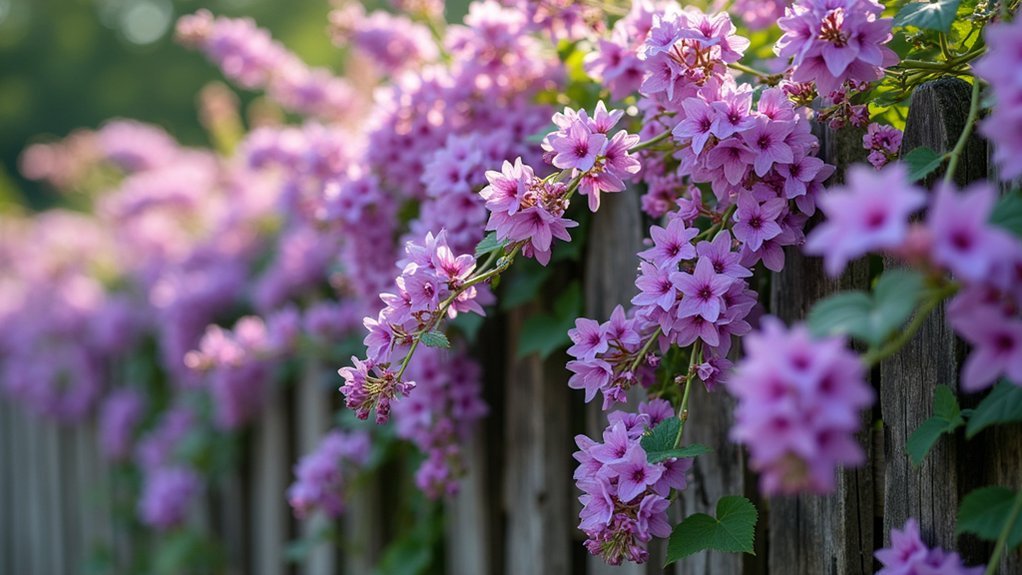
Why settle for ordinary garden boundaries when fragrant flowering vines can transform them into buzzing pollinator havens?
The Major Wheeler Honeysuckle produces vibrant red flowers that attract butterflies and hummingbirds seeking nectar sources.
For early spring pollinators, Amethyst Falls Wisteria offers cascading clusters of fragrant blue flowers that beautify your fence while supporting beneficial insects.
The Native Passion Vine creates a dense leafy curtain with purple blooms from spring to fall, becoming a season-long pollinator restaurant.
Oxford Girl climbing roses emit a powerful scent from double pink flowers that entices a variety of beneficial insects.
Don’t overlook Native Crossvine with its mocha-scented orange-red clusters that specifically appeal to hummingbirds and native pollinators during early spring when food sources are scarce.
Creating Habitat: Nesting Sites Within Your Living Fence
While vibrant blooms attract pollinators to your living fence, the true magic happens when vines transform into essential wildlife real estate.
Dense foliage from climbing plants like Virginia creeper creates protected nesting sites where birds raise their young, instantly boosting your garden’s biodiversity.
Native honeysuckle and trumpet vine do double duty – their nectar-rich flowers feed pollinators while their tangled stems provide perfect shelter for beneficial insects.
You’re creating an ecological powerhouse when you choose living fences over standard barriers.
- Small birds weave nests within the protective embrace of climbing plants
- Cavity-nesting bees utilize hollow stems for egg-laying chambers
- Butterflies shelter among dense foliage during harsh weather
- Beneficial predators like ladybugs overwinter within the layered protection
The vertical habitat you’re cultivating delivers year-round ecological value beyond simple aesthetics.
Fast-Growing Options for Quick Pollinator Coverage
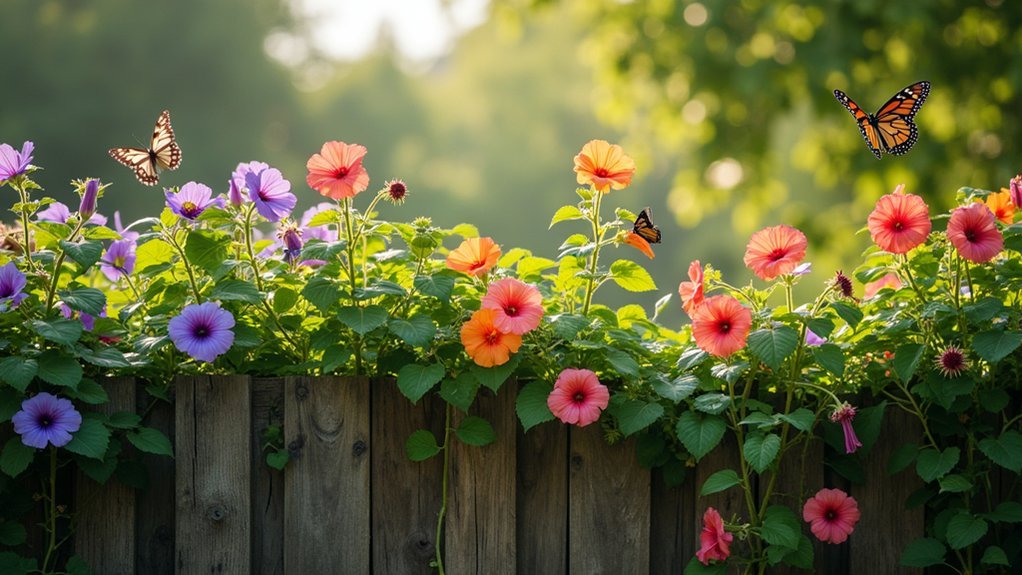
When it comes to establishing your pollinator haven, patience isn’t always a virtue. You’ll want vines that create habitat quickly while delivering immediate benefits to your local wildlife.
Virginia Creeper stands out as a remarkable fast grower, climbing 15-20 feet while providing dense foliage that transforms into vibrant fall colors.
For annual solutions, Morning Glory reaches 10 feet in a single season with trumpet blooms that bees can’t resist.
The Black-Eyed Susan Vine thrives in full sun to part shade, growing to 8 feet with bright pollinator-attracting flowers.
Don’t overlook Cypress Vine, which rockets to 15 feet with scarlet flowers that hummingbirds adore.
For maximum impact, Passion Vine grows an impressive 25 feet with fragrant purple blooms that attract diverse pollinators from spring through fall.
Companion Planting: Pairing Vines for Maximum Impact
Layering vines with different growth patterns, like the upright Clematis Tekla Garland alongside cascading Morning Glory, creates dynamic habitats that attract diverse pollinators to your garden.
You’ll maximize your space and extend the pollinator-friendly season by selecting vine combinations with complementary bloom cycles, such as early-flowering Wisteria paired with late-season Black-Eyed Susan Vine.
Strategic nutrient partnerships, like planting nitrogen-fixing Honeysuckle varieties near heavy-feeding Mandevilla, will strengthen your vine ecosystem while supporting the wildlife that depends on these floral resources.
Layering Growth Patterns
Creating a pollinator paradise requires strategic planting, and companion vines offer one of the most effective approaches. By layering fast-growing vines with slower-growing species, you’ll create a dynamic vertical garden that provides continuous blooms and abundant wildlife shelter throughout the seasons.
The key to successful layering lies in understanding each plant’s growth pattern and blooming seasons. When you pair morning glory with clematis, or wisteria with mandevilla, you’re ensuring a prolonged flowering period that supports pollinators from spring through fall.
- Combine vigorous climbers like Virginia creeper with flowering vines for structural support.
- Plant early bloomers with mid-season and late-season varieties for continuous nectar sources.
- Mix dense foliage vines with open, airy species to create microhabitats for beneficial insects.
- Integrate vines with different flower shapes to attract diverse pollinator species.
Complementary Bloom Cycles
Strategic pairing of flowering vines magnifies your garden’s appeal to pollinators by ensuring continuous blooms throughout the growing season.
Combine spring-flowering Wisteria with summer-to-fall Morning Glories to create uninterrupted nectar sources for hungry visitors.
For fragrant blooms that attract hummingbirds, pair early-season Honeysuckle with Black-Eyed Susan Vine, which flowers into fall. This thoughtful combination extends feeding opportunities for essential pollinators.
Native vines offer exceptional benefits—plant Carolina Jessamine’s early blooms alongside Passion Vine’s extended flowering period to establish a diverse habitat supporting local pollinator populations.
For visual impact with ecological benefits, integrate Clematis with chocolate-scented Chocolate Vine, or combine Virginia Creeper with Trumpet Honeysuckle.
These pairings create lush environments that nurture beneficial insects while providing continuous blooms from spring through fall.
Strategic Nutrient Partners
While aesthetic combinations delight the eye, thoughtful companion planting goes beyond beauty to enhance your flowering vine garden’s overall health.
By pairing nitrogen-fixing plants like Scarlet Runner Beans with flowering vines, you’ll improve soil fertility naturally. These strategic partnerships create diverse habitats that benefit pollinators and plants alike.
- Combine Trumpet Honeysuckle (native vine) with non-invasive Clematis for continuous nectar sources without disrupting local ecosystems.
- Plant Black-Eyed Susan Vine alongside Morning Glory to maximize vertical space while offering diverse flower shapes that attract different pollinators.
- Pair Wisteria with Virginia Creeper to guarantee bloom times extend from spring through fall.
- Interplant nitrogen-fixers between heavy-feeding flowering vines to naturally replenish soil nutrients without chemical fertilizers.
This intentional approach to companion planting guarantees your vine-covered fence becomes a sustainable pollinator haven that thrives year after year.
Maintenance Tips for Thriving Pollinator Corridors
Once your flowering vines are established, proper maintenance guarantees they’ll create vibrant pollinator corridors throughout the growing season.
Regularly water your vines, ensuring consistent moisture especially during dry periods when pollinators need nectar most.
Prune vines strategically to control their spread while promoting air circulation, which prevents disease and encourages more blooms for hungry visitors.
Apply a balanced, slow-release fertilizer in early spring to fuel robust flowering that attracts diverse pollinators.
Don’t forget to deadhead spent flowers to stimulate continuous blooming, extending the feeding season for bees and butterflies.
Finally, monitor for pests like aphids that can damage your pollinator paradise—address infestations promptly with environmentally friendly solutions to keep your living fence healthy and buzzing with activity.
Regional Considerations: Selecting Vines for Your Climate Zone
Successful pollinator havens depend largely on choosing vines that thrive in your specific climate zone. When planning your garden, check the USDA hardiness zones for each vine species you’re considering. Native plants typically perform best, as they’ve evolved alongside local pollinators and adapted to regional conditions.
Creating a thriving pollinator garden starts with selecting regionally-appropriate vines that support your local ecosystem.
- For zones 4-8, Wisteria and Honeysuckle excel in full sun to part shade locations, creating abundant nectar sources for bees and butterflies.
- Cool-climate gardeners should consider Virginia Creeper and Trumpet Honeysuckle, which attract local pollinators while tolerating variable soil conditions.
- In hot regions, select drought-tolerant options like Amethyst Falls Wisteria or Chocolate Vine that withstand summer heat.
- Always match growth habits with appropriate climbing structures—Clematis needs sturdy support while Morning Glory requires minimal infrastructure.
Frequently Asked Questions
What Are the Best Climbing Vines for Fences?
You’ll love Clematis Tekla Garland for its pink blooms, Wisteria ‘Amethyst Falls’ for fragrant coverage, Black-Eyed Susan Vine for bright colors, Carolina Jessamine for golden flowers, and native Crossvine for rapid growth.
What Is the Best Climbing Plant for Pollinators?
For pollinators, you’ll want native honeysuckle or passion vine. They’re packed with nectar, attract diverse pollinators, and bloom abundantly. Wisteria’s fragrant clusters and crossvine’s early blooms are excellent choices too.
What Is the Fastest Growing Flowering Vine?
For the fastest growing flowering vine, you’ll find Morning Glory tough to beat. It’ll climb 6-10 feet in just one season. Wisteria and Chocolate Vine grow taller but take longer to establish.
What Flowering Vine Blooms All Summer?
You’ll enjoy continuous color with Morning Glory and Black-Eyed Susan vines, which bloom all summer into fall. Climbing Nasturtiums also provide long-lasting blooms, and under ideal conditions, Wisteria may rebloom throughout summer.
What Are the Vines That Strangle Trees Called?
These tree-strangling plants are called “smothering vines.” You’ll recognize species like English Ivy, Wisteria, and Japanese Honeysuckle that wrap tightly around trunks, restricting growth and blocking sunlight. Virginia Creeper can also cause damage.
In Summary
By transforming your fence into a flowering vine paradise, you’ve created a valuable ecosystem right in your backyard. You’ll enjoy both the visual beauty and the satisfaction of supporting local pollinators with your living fence. Remember to choose native varieties whenever possible, maintain your vines with seasonal care, and watch as butterflies, bees, and hummingbirds make your garden their home.

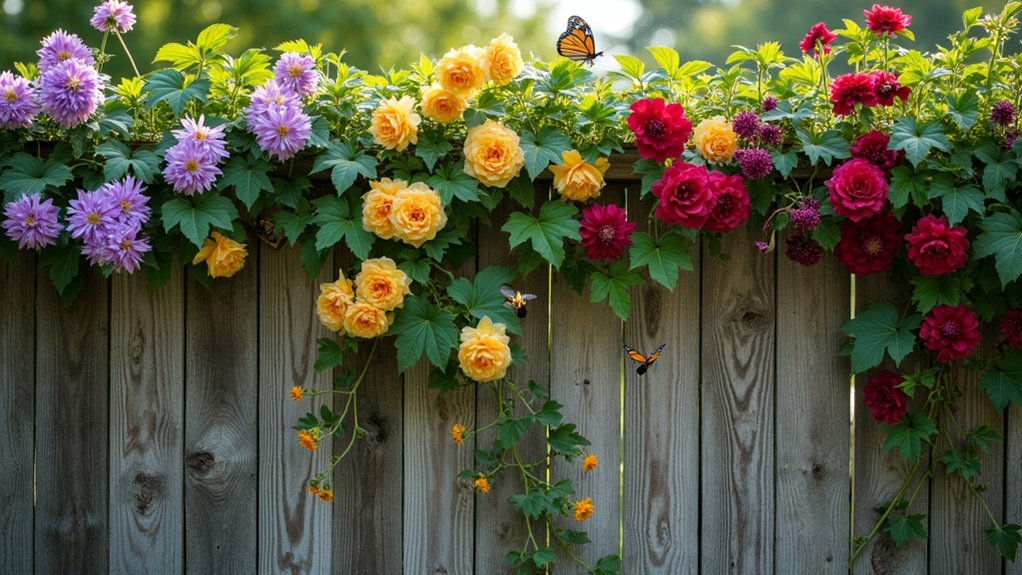



Leave a Reply